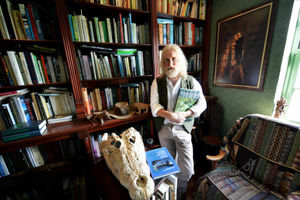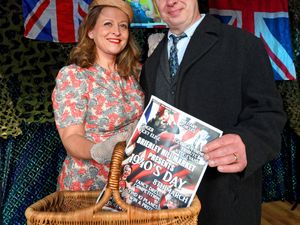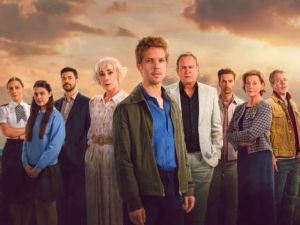Mark O'Shea of West Midlands Safari Park talks all-things reptile
Many people have a fear of snakes but Mark O'Shea has made a career out of scouring the globe for them.

From finding new species to discovering more about those already identified, he's had plenty of adventures along the way.
But for the explorer it's all about expanding our knowledge of the natural world.
"It's still the age of discovery and I find this really exciting," says Mark, who is Consultant Curator of Reptiles at West Midland Safari Park.
"It's like we are standing on the edge of known knowledge and looking over.
"There is still so much we don't know and our techniques are improving all the time so there's always something new to learn and it's great to be able to contribute to that," he adds.
Now much-travelled Mark shares his time between research and field trips, speaking at conferences and universities and his role at the safari park.
Mark has just returned from a month in Australia, working in museums and presenting lectures, and a week in Sri Lanka where he was guest speaker at an international partner's symposium for the University of Wolverhampton.
Last year he was lecturing in the Czech Republic, Costa Rica and Mexico, conducting museum research in Germany and Holland, and he also made a photographic trip to Morocco.
He feels fortunate to have been able to turn his boyhood hobby into a career that has seen him work all over the globe and become a household name thanks to his television series' on the Discovery Channel, Animal Planet and Channel 4.
It all began when he was just eight-years-old and he had an encounter with a common boa (Boa constrictor) at Dublin Zoo.
"It was twice as long as I was tall. I was able to hold it and it was magical," he recalls smiling.
Now some people will shudder just at the word 'snake' but Mark believes they have has earned our respect.
"There's no other creature that has immersed itself in our religion, culture and psyche like the snake has.
"People revere snakes and people fear snakes. In some cultures they are associated with death and in others with longevity. They have a powerful effect on us," he explains.
So you would expect a man with a life-long love of snakes to have a vivarium or two at his home in Shropshire. But he doesn't because Wolverhampton-born Mark, who once did keep a thriving collection of snakes, now prefers to study them rather than keep them himself.
"I've kept many snakes when I was younger but I no longer feel the need. Now I study snakes in the wild or in museums and I find that much more rewarding and exhilarating," explains the 60-year-old.
This is one of the reasons why he is a great advocate for national history museums saying they can offer many opportunities for new discoveries.
"A lot of people think natural history museums are crusty places where nothing exciting happens but they are really treasure houses, as much as any art gallery.
"What people don't realise when they go to a natural history museum is that in the public galleries they are seeing only a tiny fraction of what the museum holds, like the the shop window of a large department store. Behind the scenes there are so many, many more different and important specimens, and much research is being conducted. Even what we thought we knew can sometimes be wrong.
"There is so much waiting to be discovered and this can be fascinating work.
"I've held objects and specimens at museums that were collected by Charles Darwin and Alfred Russel Wallace – for me that's amazing, a direct connection to those great men."
Chance encounters have also led to new discoveries by Mark who is known throughout the world for his television programmes on animals for Channel 4 and the Discovery Channel.
During a visit to the Museum of Comparative Zoology at Harvard University, he discovered a new species of Toxicocalamus – a genus of secretive venomous New Guinea snakes.
After examining 92 specimens of Toxicocalamus over four days and finding himself with some spare time, he started to look at the other Papuan snake specimens in the museum's spirit collection.
"I got out 24 specimens of Micropechis ikaheka and I placed their jars in a row.
"But there was one that was a metre long and I looked at it and said 'what are you?'. I knew it wasn't a Micropechis. From the scales of its head I knew it had to be another Toxicocalamus but it wasn't a known species.
"The specimen had been collected in 1969 and had been mislabelled ever since. No one knew what it truly was until I looked at it all these years later," he explains.
After a new discovery, he writes a paper describing the new species which is then submitted to a journal for peer reviews before it is published. The whole process can take between 12 and 18 months.
"It takes a long time but it's very satisfying, I named the new snake after the biologist Ernst Mayr because it was an Ernst Mayr Travel Award that got me to Harvard and brought me into contact with the specimen," he says.
Field work is another important part of his job and this has seen him get into a number of scrapes over the years and struck down by malaria six times.
Snake bites are an unfortunate hazard of the job. His first rattlesnake bite happened during an expedition with The Royal Geographical Society in the late 1980s.
Without any of today's technology to keep in touch, his team relied on shortwave radios while out in the Amazon to stay in contact with the base in Boa Vista, northern Brazil. But they would only be switched on for 10 minutes. Unfortunately for Mark, he was bitten on the right thumb by the rattlesnake.
They had anti-venom but had struggled to keep it cold enough and were concerned about whether it was safe to use. They held off from administering it but Mark's arm began to swell.
At 3am as the swelling reached his elbow they decided to use the anti-venom via a saline drip.
But Mark began to have a reaction to the anti-venom. "I went blind which was quite worrying because I didn't know how long it would last – was it just going to be 10 minutes, a day or forever?," he recalls.
The expedition nurse stopped the drip and administered adrenaline and his vision returned. It was then restarted at a slower rate and he showed signs of improvement as they waited until it was time to switch on the radio and request a medivac.
"I was quite lucky really. I was saved by it only being a small rattlesnake. If it had been one of the 5ft long specimens I had caught I wouldn't be here speaking to you now," he says.
He still gets recognised because of his television programme O'Shea's Big Adventure, which was also known as O'Shea's Dangerous Reptiles.
"It's nice that people enjoyed watching me doing what I enjoy. When I was making the films I was just doing what I would normally do in my field work so it's really pleasing that they've made such an impact," he says.
"I feel very fortunate to have had the experiences and adventures I've had and I hope to have many more."
By Heather Large




